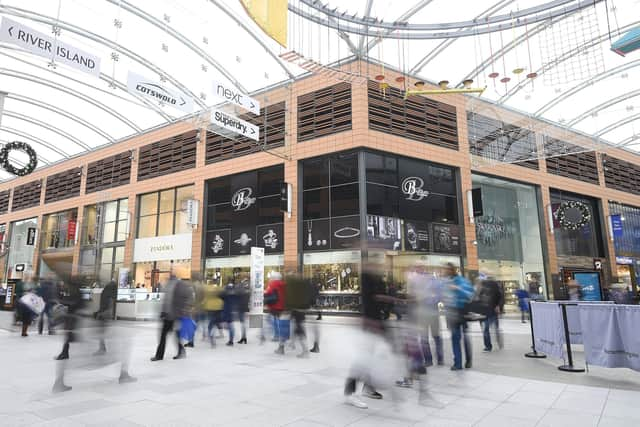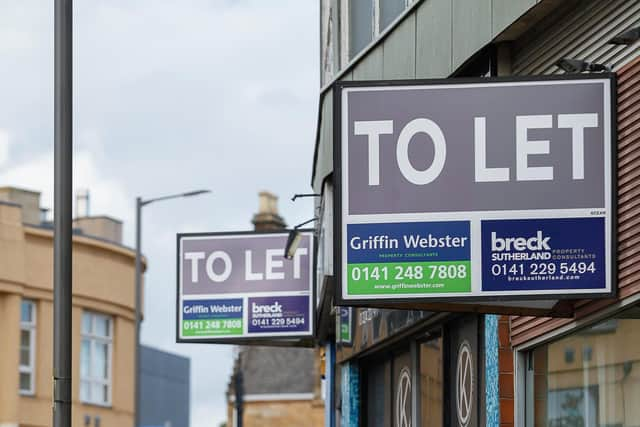In depth: pockets of resilience remain in Scots retail despite jump in vacant units
and live on Freeview channel 276
The Scottish vacancy rate indeed worsened to 15.9 per cent in the second quarter of this year, according to the latest Scottish Retail Consortium (SRC)/Local Data Company (LDC) monitor out today that also highlights the need for more action to redevelop empty units and to keep a lid on surviving retailers’ overheads – although pockets of resilience remain. Additionally, the latest figure is 0.2 percentage points worse than both the previous quarter and the year-ago period.
Making for even bleaker reading is the news that Scotland has had the biggest leap out of every region in empty units since the onset of the pandemic, at 3 per cent, with the next-highest figure 1.7 per cent for Greater London. Half of the areas showed a drop of under 1 per cent, while North-west England managed to notch up an improvement of 0.6 per cent.
Advertisement
Hide AdAdvertisement
Hide AdSRC director David Lonsdale addressed the latest statistics, saying: “These are cheerless figures for retailers with physical bricks-and-mortar premises and for the health of Scotland’s retail destinations.


"Scotland’s shop vacancy rate nudged up in the second quarter and reached its highest level in 18 months, once again sitting above the UK average rate. The proportion of empty units is a quarter higher than three years ago, underlining the toll wrought by the pandemic and subsequent costs crunch.”
However, he noted that the “troubling” increase in empty units wasn’t seen across all destination types, with retail parks showing relative resilience, seeing vacancies improve to 9.4 per cent, also showing that shoppers’ appreciation of the ability to park on site is not to be underestimated. On the other hand, shopping centre vacancies worsened slightly to 20.7 per cent from 20.6 per cent in the prior three-month period, while on the high street, they deteriorated to 15.1 per cent.
Call to action
Lonsdale consequently cited the “need for concrete action from policy-makers to keep down the cost of operating premises”. He added: “With stores here missing out on rates relief available to their counterparts in Wales and England, Scotland’s shopkeepers will be looking to ministers and their tax advisers to get a grip on the onerous headline business rate – and to deliver on the government’s ambition to ‘use business rates to boost business’.
Advertisement
Hide AdAdvertisement
Hide Ad

“After all, the business rate is at a 24-year high, and government forecasters have pencilled in a chunky uplift for next spring, which, if implemented, would add £34 million to retailers’ rates bills. The Finance Secretary must carefully assess the impact on firms and hard-pressed retail destinations when she comes to set the business rate in the Scottish Budget.”
The latest findings also follow in the footsteps of the SRC's sales monitor released last week, showing that total retail sales north of the Border grew by 2.9 per cent year on year in June, the best monthly performance since Christmas. That followed footfall stats published earlier in July by the organisation showing that Scottish high streets saw a decline in June, but fared well in comparison to other parts of the UK.
Regarding the figures out today, LDC commercial director Lucy Stainton said: “The headline findings from Q2 are unlikely to have come as a surprise to anyone, with economic pressure from rising interest rates and inflation already mounting as the year began. Current challenges to businesses have been compounded by tightening discretionary spend and a dip in confidence among consumers. The economic headwinds that have made the headlines have filtered into the data, reflected in a slight rise in the overall vacancy rate.
“The high street has seen some of the most notable impacts, with rising rents and increased competition putting pressure on small and independent businesses, who may struggle to meet high operating costs. Across all location types, vacancy has reached critical levels, highlighting an ever-increasing need to redevelop units to breathe life back into retail destinations.”
Advertisement
Hide AdAdvertisement
Hide AdChanging landscape
Scotland certainly has examples of towns with boarded-up units where there were once bustling shops, including Falkirk and Ayr, and ages-old high-street retail bellwethers that have now closed their tills for the last time including Jenners in Edinburgh.
But some locations are proving resilient, such as St Andrews, North Berwick, Duns, Peebles, Auchterarder, and Nairn – as well as Livingston, within a one-hour journey for 60 per cent of Scotland’s population, and whose designer outlet last year experienced a 9.92 per cent like-for-like sales jump from 2019, the year it received a £7m facelift. Many such locations enjoy advantages such as high tourist footfall, affluent local populations, decent parking, and unique and specialist shops with no domineering retail behemoth.
Further cause for optimism came earlier this year via analysis from commercial property consultancy Knight Frank finding that Edinburgh continued to have the lowest retail vacancy rate of the UK’s major cities, excluding London. "The introduction of St James Quarter has meant different areas have re-established themselves or begun to carve out their own distinct identities,” it said.
LDC’s Stainton also praises pockets of strength in the shopping sector overall, and heralds players’ will to survive. “Retail is a diverse industry; each retail and leisure subsector faces its own unique challenges, but also, importantly, has its own unique strengths,” she said. "Retail parks [for example] have shown us excellent examples of agile strategy in action, splitting larger units into smaller ones or converting space for alternative uses to successfully revitalise vacant stock.
Advertisement
Hide AdAdvertisement
Hide Ad"The current climate is undeniably difficult, but it should not be overlooked that today’s retailers are more innovative and future-thinking than ever… we do not foresee any improvements to vacancy rate in future. However, given that the latest rises in vacancy have not been particularly significant, we anticipate that any increases in the near future will be gradual.”
Comment Guidelines
National World encourages reader discussion on our stories. User feedback, insights and back-and-forth exchanges add a rich layer of context to reporting. Please review our Community Guidelines before commenting.